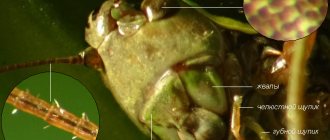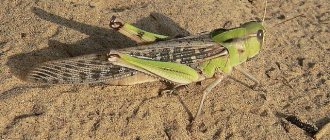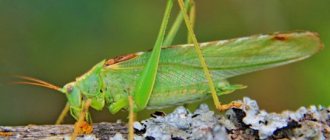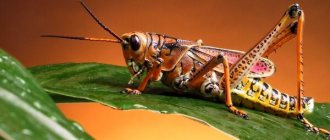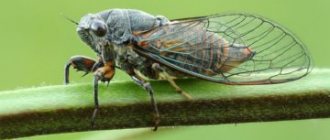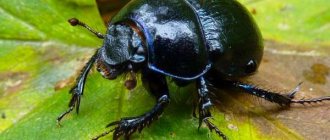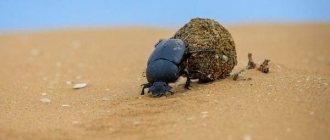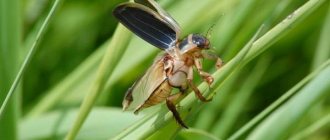The grasshopper is an arthropod insect, belongs to the superorder New-winged insects, order Orthoptera, suborder Orthoptera, superfamily grasshoppers (Tettigonioidea).
The Russian word "grasshopper" is considered a diminutive of the word "smith". But, most likely, it has nothing to do with the forge, but comes from the Old Russian “izok”, meaning “June”. Almost 7 thousand known species of grasshoppers live on every continent except Antarctica. Due to such diversity, even an experienced entomologist cannot always determine the species identity of a particular individual.
Grasshopper: description and photo. What does an insect look like?
Most species are distinguished by an elongated body, a laterally compressed head and two oval, faceted grasshopper eyes. Powerful gnawing jaws help the insect deal with prey and tear off pieces of food. Depending on the species, the length of a grasshopper can range from 1.5 to 15 cm.
Most grasshoppers have a back pair of legs designed for jumping. Their femurs are thickened at the base, their shins are elongated, equipped with spines and movable “spurs”. The thigh of the jumping leg is connected to the lower leg in a special way - “back with the knee”, which allows insects to jump over gigantic distances by their standards. The other two pairs of grasshopper legs are of the running type. Pushing off with enormous force, the grasshopper jumps a long distance. The length of a grasshopper's jump can be 20 times the length of its body.
The sensitive antennae of the grasshopper, which perform the function of touch, are much longer than the body in some species.
Some species of grasshoppers are endowed with two pairs of wings, used for flight and as a protective covering.
Building[edit | edit code]
The head has a separate apex of the crown, often laterally compressed, sometimes cone-shaped. The tarsus are four-segmented. Pronotum with a flat or convex top and flat lateral lobes drooping downwards. The male elytra often has a chirping organ. The venation with a sharply separated RS, in the area of the chirping organ, is strongly modified. Often the elytra and wings lose their flight functions, but retain, often enhanced, the chirping organ. The female's ovipositor is, with very rare exceptions, long and laterally compressed.
The chirping of a grasshopper. What does a grasshopper chirp with?
If we talk about what the grasshopper chirps and what sound it makes, then this moment is very interesting. On the left elytra of the grasshopper there is a membrane with a thick stridulatory vein, which has denticles - it plays the role of a bow. And on the right elytra there is a membrane that plays the role of a resonator. When chirping, the grasshopper vibrates its elytra, raising them.
Each species of grasshopper produces sounds that are unique in melody and volume. The ability to chirp is endowed mainly with the male grasshopper and only a few species of females. Other individuals are wingless or have very poorly developed wings, so they cannot chirp or make other sounds.
The color of grasshoppers in nature depends on their habitat, is an excellent camouflage and can combine different shades of the same color (for example, green), as well as bright spots or spectacular stripes.
By the way, you can read about the difference between locusts and grasshoppers in the article about locusts.
Amblycorifa
Grasshoppers can be more than just green. This is clearly demonstrated by the grasshopper - amblycorifa. Representatives of this species can be dark brown, pink and even orange! There is also a traditional green color. Interestingly, the color of a particular grasshopper is determined without any pattern. This is not affected by either the habitat or the color of the parents. However, dark brown and orange colors are very rare.
Where is the grasshopper's ear?
The complex hearing apparatus, that is, the grasshopper's ears, is located on the shins of the insect's front legs. Thus, we can say that the grasshopper hears with its feet. The oval membranes that are located on both sides of the lower leg act as eardrums. In some species of grasshoppers, the membranes are open, in others they are closed with special caps. The structure of the hearing aid consists of nerve endings, muscles, and sensory cells. The structure also includes 2 branches of the trachea, which approach the eardrums.
Grasshoppers have noticeable sexual dimorphism: females are much larger than males and have a sickle-shaped or straight, arrow-like ovipositor. The lifespan of a grasshopper, including the egg stage, is only one season.
Fat guy
The species is European, on the verge of extinction, included in the species of large grasshoppers . Males of the species are 8 cm long. The length of females is 6 centimeters.
The names of grasshoppers are often based on their appearance. A fat man, for example, looks plump, even fat. Due to this, the visually black-brown body of the insect appears shorter. Volume is also added by sharp keels on the sides of the grasshopper's pronotum.
Fat grasshopper
Greenhouse grasshoppers
They are hunchbacked and stocky. The body of greenhouse grasshoppers is shortened, but females have a long ovipositor. Representatives of the genus are also distinguished by long legs and mustaches. The latter reach 8 centimeters.
Types of grasshoppers, photos and names
Below is a brief description of some grasshoppers.
- Dybki (Saga)
These are large grasshoppers living in Europe, Asia, South Africa, Australia and North America.
Steppe dybka
- Green grasshopper (Tettigonia viridissima)
Insect 2.5 - 4 mm long. This species lives throughout Europe, Asia, Africa, in the middle zone and in the south of Russia.
Grasshopper green
- Greenhouse grasshopper (Tachycines asynamorus)
Small insects that look like spiders. Introduced to Europe and America from China, they live in greenhouses and greenhouses, feeding on the leaves and flowers of plants.
Greenhouse grasshopper
- Ball-headed grasshoppers (Bradyporidae)
Orthoptera, long-whiskered insects with a spherical head. These include the steppe fatty - a large black-bronze grasshopper. This species, listed in the Red Book, lives in the Krasnodar and Stavropol Territories, in Chechnya and North Ossetia;
Steppe fat man
By the way, the largest grasshopper in the world is the Giant Weta, whose impressive weight reaches 70-80 grams.
The world's smallest grasshopper is the greenhouse grasshopper.
The world's largest grasshopper is the Giant Weta.
Popular message topics
- Creativity of Valentina Oseeva
Valentina was born at the beginning of the last century in Kiev. Due to participation in the revolutionary movement, her family often had to move. Observing various picturesque paintings, landscapes, - Pharaoh
The best of the female pharaohs. It is believed that throughout her reign, Egypt was at its peak. Hatshepsut was special, because not every woman can maintain power for 22 years in the world of patriarchy. - Antimonopoly legislation of the Russian Federation
Monopoly is a situation when the market is dominated by one or more producers of goods or services, and these producers unite in order to win consumers, suppress competitors and control prices.
What does a grasshopper eat?
For the most part, the grasshopper is a predator, mercilessly destroying clutches of insects, aphids, caterpillars, butterflies, beetles, ticks, and small locusts in its path. If you are unlucky with hunting, unpretentious insects are content with young shoots of plants. The food of some species of grasshoppers is exclusively plant-based: grasshoppers eat grass or leaves of trees (for example, birch and chestnut trees), and some of them are noted as serious agricultural pests. Unlike the same related locusts, which eat farmers' crops, grasshoppers are more beneficial. For example, they help get rid of the Colorado potato beetle, which has taken a fancy to potato fields.
In conditions of autonomous maintenance and lack of nutrients, grasshoppers have even been observed in cannibalism, that is, eating their own kind. A simple experiment showed that if you put several of these insects in a closed jar and leave them without food for a couple of days, the group will eventually suffer losses among their relatives.
It may seem surprising, but if the grasshopper does not receive its “dose” of protein and salts from ordinary food, then it does not disdain to feed on feces and carrion, and also eats its weaker relatives with appetite.
Dragonfly
The dragonfly is an equally beautiful insect in nature. You can meet a dragonfly in the summer, on the shore of a reservoir. They come in different colors: black, white, blue and green.
The dragonfly has 4 wings, two of which are slightly longer; they serve as its controls, literally like a steering wheel in a car. The eyes of a dragonfly are facets, shimmer with all the colors of the rainbow and occupy almost the entire space of the head; they consist of small eyes. There are approximately 28 thousand of them!
We talked about the dragonfly’s extraordinary vision when we shared our impressions of visiting the science museum.
Interesting facts about dragonflies
- In Japan, the dragonfly used to be a sign of victory.
- The dragonfly has a surprisingly good appetite; it can eat about 40 flies in an hour.
- Dragonflies lay eggs in water. Once hatched, the larvae can live underwater for two years.
- The wings and body of a dragonfly are designed in such a way that it is not only able to withstand long migrations, but can also hover in the air, fly sideways, backwards, forwards, at any angle and in any direction.
Where do grasshoppers live?
The habitat of grasshoppers is diverse - they thrive in tropical jungles and sultry deserts, they live in the tundra zone and in high alpine meadows. You can meet a grasshopper in thickets of bushes and in a wheat field, at the edge of a forest and in steppe herbs. These “jumpers” settled across all continents - from Eurasia to Australia, with the exception of icy Antarctica and too hot deserts. Unlike other long-whiskered orthoptera, grasshoppers live openly on plants and do not use burrows in the soil or wood.
Taxonomy[edit | edit code]
The following subfamilies are distinguished in the grasshopper family:
- Acridoxeninae
- Agraeciinae
- Austrosaginae
- Bradyporinae - Ball-headed grasshoppers
- Conocephalinae
- Copiphorinae
- Decticinae
- Hetrodinae
- Lipotactinae
- Listroscelidinae
- Meconematinae - Knotwhiskers
- Mecopodinae
- Microtettigoniinae
- Phaneropterinae - Plate wings
- Phasmodinae
- Phyllophorinae
- Pseudophyllinae
- Saginae - Dybki
- Tettigoniinae - True grasshoppers
- Tympanophorinae
- Zaprochilinae
Adaptation of grasshoppers to their environment
Many animals feed on grasshoppers, and they face death every second. Therefore, they fight for life, using all the opportunities given by nature. The main methods of defense of grasshoppers are protective and dismembering coloration, the ability to hide, jumping legs, spines with which they signal to relatives about approaching danger, and the ability to bite. For example, the leaf grasshopper from Sudan can bite through human skin until it bleeds. But there are also lesser-known types of protection for these insects.
When threatened, some grasshoppers can tear off their legs. The ability of animals to break off body parts is called autotomy. Grasshoppers easily lose one of their hind legs, and sometimes both. Close to the phenomenon of autotomy is the process of self-mutilation - gnawing off limbs in response to irritation. This is especially common in some grasshoppers.
Protective coloring seems to be a simple and primitive way of protection. Grasshoppers also use other, more complex methods of deception. Mimicking leaves is a favorite technique used by many insects. One of the grasshoppers of the species Cycloptera elegans looks very much like a dried leaf. The similarity is enhanced by spots on its wings, reminiscent of a fungal infection of the leaves.
Another grasshopper from the genus Pterochosa, living in America, is similar in color, pattern, and arrangement of veins to a withering and discarded leaf. There are spots on its wings that resemble damage to leaves by leaf miners. This ideal method of copying was called “hyperthemia” (overimitation).
Other species imitate the resemblance to a twig protruding from a trunk, lichen growths on tree trunks. There are grasshoppers that can scare away attackers with a squeal and cause disgust with a drop of regurgitated gastric juice.
Photo credit: gailhampshire, CC BY 2.0
Ladybug
In nature, it is not difficult to recognize this insect. Even the smallest child is friends with the ladybug. Probably each of us said:
“Ladybug, Fly to the sky, There your children eat candy, they give it to everyone, but they don’t give it to you.”
It turns out that the ladybug is not so harmless. She is a predator, feeding on aphids, crickets, spiders and other insects that harm plants. This type of beetle brings great benefits to our nature.
Interesting facts about ladybugs
- The French believed that the ladybug protected against misfortune; they wore talismans with a design of this insect.
- In the Czech Republic, it was believed that a ladybug promises good luck.
- During flight, a ladybug makes up to 85 wing beats per second.
- During its life, this bug lays up to 2000 eggs, and some of them are both fertilized and not. Unfertilized “empty” eggs serve as food for the young.
- Ladybugs overwinter, gathering in large colonies under stumps, stones, in tree crevices...
Reproduction and development of grasshoppers
Grasshoppers of temperate latitudes begin breeding in May - June, tropical species breed regardless of the season. Males attract females with loud trills and a special spermatophore vial consisting of seminal fluid and a sticky nutrient. When mating, the male hangs the vial from the abdomen of the female grasshopper, and she begins to eat the sticky part, while the seminal fluid flows into the female's oviduct.
Laying eggs lasts several hours; in different species of grasshoppers, a female’s clutch can contain from 100 to 1000 eggs. Grasshoppers lay large, oval eggs directly in the ground, attach them to branches and grass stems, and hide them in dry wood or under the bark of trees.
In temperate latitudes, the clutch overwinters in the ground until next year.
Stages (cycle) of grasshopper development - diagram
The grasshopper larva looks like a small adult that lacks wings. The exceptions are the Sudanese grasshopper, whose larvae resemble ants, and the Malayan grasshopper, the young of which resembles a jumping beetle.
The development of a grasshopper larva consists of a series of successive molts, which can be from 4 to 6. That is, the grasshopper molt occurs precisely in the larva.
Grasshopper molt
Butterfly
Let's start with the most beautiful species - Butterflies. Butterflies feed on the nectar of flowers, thereby pollinating plants.
The butterfly is known for its amazing metamorphoses. In the summer season, they lay eggs in the ground or on plants, from which the caterpillar hatches; after a while, the caterpillar enters the pupa stage (this is a small cocoon in which the future butterfly develops). The cocoon hangs practically motionless until the fruit ripens, and then a beautiful butterfly hatches.
It’s interesting that I talked about the butterfly here and in my favorite author’s book, “The World of Insects.”
Interesting facts about butterflies
- There are many legends about butterflies; in particular, in ancient Rome they believed that a butterfly was a flower petal that was torn off by gusts of wind
- The largest butterfly is the South American moth Tizania agrippina, its wingspan is up to 31 cm! (By the way, we already admired such a giant butterfly in the life-size book “Compare!”)
- And the wingspan of the smallest butterfly - acetosia - is only 2 mm.
- Butterfly wings are made up of tiny scales! Each of which has only one color. And the scales, like a mosaic, form complex patterns of wings.
- Butterflies' taste buds are on their paws.
- The eyes of a butterfly, like an ant, are made up of facets.
- To take off, the butterfly first flaps its wings in place to heat its body to a temperature above 30-35 degrees.
- Butterflies feed on flower nectar, honey, pollen, manure, fermented fruits, and even human sweat! If a butterfly comes to visit you, you can treat it with sugar syrup.
- Butterflies don't sleep. But they rest and during rest they may not move at all.
- A butterfly is known to have 4 stages of development: egg, caterpillar, pupa and butterfly.
- By the way, some caterpillars feed on poisonous plants. The butterflies that hatch from them turn out to be poisonous to birds!
- In Japan they believe that seeing a butterfly in the house is good luck. There is even a special “butterfly dance” that opens all holidays and ceremonial processions.
For more information about the butterfly, look here:
How to make a butterfly with your own hands
Poems and riddles about a butterfly
Interesting facts about the grasshopper
- With the exception of some species of grasshoppers that readily eat tea and citrus plantations, these insects do not cause much harm. In Chinese cuisine, grasshopper is a common ingredient and is also included in the regular menu of African and Asian aborigines.
- Thanks to its powerful jaws, a grasshopper bite, accompanied by a death grip, can be very painful for humans.
- Sweet-sounding insects, grasshoppers are often kept in captivity as pets. Several individuals are placed in a spacious aquarium - an insectarium, the bottom is covered with sand and a little vegetation is added. A dense diet consisting of fruits, vegetables and the obligatory live food: flies, spiders and butterflies will help to avoid the cannibalism inherent in insects.
Did you like the article? Share with your friends:
